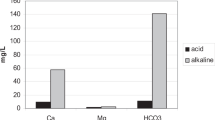Summary
Pure colloidal silicic acid particles of 20–100 Å were added to the drinking water of 36 guinea pigs for 4–11 months, first in a concentration of 300 mg/l, then as 600 mg/l during the last 3 months. Compared with 24 control animals, concentrations of serum creatinine, BUN and standard bicarbonate as well as urinary protein excretion failed to reveal functional renal disturbances. Histological examination of the kidneys in animals exposed to silicic acid showed pathological atypical material in the collecting ducts, interstititial infiltrations, focal necrotic areas and dicrete glomerular changes. However, as similar changes in equal frequency were also present in the control animals, it would seem that colloidal silicic acid added to drinking water in the above concentrations was not nephrotoxic. These results are not consistent with the hypothesis that silicates are of primary significance in the pathogenesis of Balkan nephropathy.
Zusammenfassung
Dem Trinkwasser von 36 Meerschweinchen wurde während 4–11 Monaten reines Kieselsäurekolloid mit einer Partikelgröße von 20–100 Å in einer Konzentration von 300 mg/l, in den letzten 3 Monaten 600 mg/l zugesetzt. Im Vergleich zu 24 Kontrolltieren ließen sich nach einer Expositionsdauer von 4, 8 und 11 Monaten gemessen an Kreatinin-, Harnstoffstickstoff- und Standardbicarbonat-Konzentration im Blut sowie der Eiweißausscheidung im Urin keine Zeichen einer funktionellen Nierenschädigung nachweisen. Die histologische Untersuchung der Nieren der exponierten Versuchstiere nach der gleichen Expositionsdauer ergab wohl mit atypischem basophilem Material in den Sammelrohren, interstitiellen Infiltraten, Nekroseherden und diskreten glomerulären Veränderungen gewisse pathologische Befunde. Diese pathologischen Veränderungen waren jedoch bei den Kontrolltieren ebenso häufig und in gleicher Frequenz nachweisbar. Aus den Versuchen muß geschlossen werden, daß der Zusatz von kolloidaler Kieselsäure zum Trinkwasser in den gewählten Konzentrationen für Meerschweinchen nicht nephrotoxisch wirkt. Diese Resultate sprechen nicht für eine Bedeutung von Silicaten bei der Entstehung der endemischen Balkan-Nephropathie.
Similar content being viewed by others
Literatur
Abdussalam, M.: The endemic nephropathy of South-Eastern Europe. Bull. de l'OMS32, 431–448 (1965)
Biberi Morcianu, S.: Einige allgemeine Betrachtungen über die endemische Nephropathie in Rumänien. International Symposium on Endemic Nephropathy. Bulgarian Acad. Sci. Press, S. 149–154 (1965)
Boyadziev, N., Pačera, I., Rajikova, B., Naplatarova, N,. Kyumdjeva, T., Stančev, P.: Investigations into the hydrogeological conditions and composition of drinking waters in areas with endemic nephropathy. International Symposium on Endemic Nephropathy. Bulgarian Acad. Sci. Press, S. 176–181 (1965)
Bruckner, I., Zosin, C., Lazarescu, R., Paraschiv, D., Manescu, N., Serban, M., Titeica, M.: A clinical study of nephropathy of an endemic character in the People's Republic of Rumania. International Symposium on Endemic Nephropathy. Bulgarian Acad. Sci. Press, S. 25–35 (1965)
Bulič, F.: The possible role of genetic factors in the etiology of the Balkan nephropathy. Ciba Foundation. The Balkan nephropathy, S. 17–27. London: Churchill 1967
Burckhardt, P. (SUVA): Mündliche Mitteilung
Cracium, E. C., Rosculescu, I.: On Danubian endemic familial nephropathy (Balkan nephropathy). Amer. J. Med.49, 774–779 (1970)
Danilović, V.: Chronic nephritis due to ingestion of lead-contaminated flour. Brit. med. J.1958 I, 27–28
Danilović, V., Stojimirovič, B., Djurišic, M., Ignjačev, Z.: Kurze Übersicht unserer bisherigen Untersuchungen über die chronische endemische Nephropathie in Serbien. International Symposium on Endemic Nephropathy. Bulgarian Acad. Sci. Press, S. 36–41 (1965)
Gaon, J. A.: Endemic nephropathy in Bosnia. Ciba Foundation. The Balkan nephropathy, S. 51–71. London: Churchill 1967
Georgiev, G., Dimitrov, T.: A study on endemic nephritis in the village of Bistretz, Vratza district. International Symposium on Endemic Nephropathy. Bulgarian Acad. Sci. Press, S. 245–249 (1965)
Glatschew, P.: Über das Wesen der sogenannten Balkan-Nephropathie. Schweiz. med. Wschr.100, 653–656 (1970)
Marković, B.: Endemische Nephropathie in Jugoslawien. Schweiz. med. Wschr.98, 417–420 (1968)
Marković, B.: Conditions requises pour provoquer expérimentalement la néphrite interstitielle chronique (endémique) par des silicates sur des animaux d'expérience dans les laboratoires et par des eaux potables dans les foyers de nephropathie endémique. Archives de l'Union Médicale Balkanique, T.V. No.6, 604–610 (1967)
Marković, B.: Substratum histopathologique de la néphrite endémique. J. Urol. Néphrol.74, 843–847 (1968)
Marković, B.: Conditions expérimentales pour la provocation au laboratoire de la néphrite interstitielle chronique sur des animaux de laboratoire par des silicates naturels additionnés aux eaux potables. J. Urol. Néphrol.76, 695–711 (1970)
Pappenheimer, J. R.: Über die Permeabilität der Glomerulummembranen in der Niere. Klin. Wschr.33, 362–365 (1966)
Petrinska-Venkovska, S.: Morphological aspect of endemic nephropathy in Bulgaria. International Symposium on Endemic Nephropathy. Bulgarian Acad. Sci. Press, S. 95–104 (1965)
Popović, B.: Research work on affected animal kidneys in the endemic region of southern Serbia. International Symposium on Endemic Nephropathy. Bulgarian Acad. Sci. Press, S. 155–163 (1965)
Puchlev, A., Popov, N., Astrug, A., Dotschev, D., Petrinska, S.: Über die endemische Nephritis in Bulgarien. Schweiz. med. Wschr.91, 751–756 (1961)
Schouroup, K.: Structure of tubular changes in endemic nephropathy. Ciba Foundation. The Balkan nephropathy, S. 100. London: Churchill 1967
Shindarov, L., Miltov, G., Matova, E., Ninov, N.: Virological studies of the etiology of endemic nephropathy. International Symposium on Endemic Nephropathy. Bulgarian Acad. Sci. Press, S. 232–235 (1965)
Tančev, J.: Studies on the socio-economic conditions in villages of Vratza district affected by endemic nephropathy. International symposium on Endemic Nephropathy. Bulgarian Acad. Sci. Press, S. 137–141 (1965)
Zaharia, C., Bîrzu, I., Popescu, G., Torjescu, V.: Endemic renal disease (renal atrophy) in Rumania. International Symposium on Endemic Nephropathy. Bulgarian Acad. Sci. Press, S. 57–72 (1965)
Author information
Authors and Affiliations
Rights and permissions
About this article
Cite this article
Benninger, J.L., Graepel, P. & Hodler, J. Fehlen von Nierenveränderungen nach langdauernder Kieselsäureverabreichung beim Meerschweinchen; ein Versuch zur ätiologischen Klärung der endemischen Nephropathie im Balkan. Res. Exp. Med. 162, 215–226 (1974). https://doi.org/10.1007/BF01851243
Received:
Issue Date:
DOI: https://doi.org/10.1007/BF01851243



